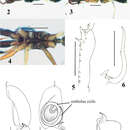Myrmarachne acutidens: Brief Summary
(
шпански; кастиљски
)
добавил wikipedia ES
Myrmarachne acutidens es una especie de arañas araneomorfas de la familia Salticidae.
- лиценца
- cc-by-sa-3.0
- авторски права
- Autores y editores de Wikipedia
Description
(
англиски
)
добавил Zookeys
(male/female). Carapace length 1.50–2.00 (1.90) /1.88–2.20, width 0.83–1.17 (1.10) /0.88–1.07. Chelicera length 1.08– (1.83). ALE–PLE 0.58–0.77 (0.75) /0.65–0.75; ALE–PME 0.26– (0.35) /0.30–0.37. Width of eye row I 0.78–1.05 (1.02) /0.86–1.03; II 0.73–0.98 (0.95) /0.80–0.93; III 0.84–1.13 (1.08) /0.93–1.10. Eye size: AME 0.25–0.37 (0.33) /0.28–0.33; ALE 0.13–0.16 (0.15) /0.13–0.17; PME (0.05) /0.05; PLE 0.14–0.19 (0.16) /0.14–0.16.
Male (Figs 2–9). Cephalic part almost flat dorsally, distinctly higher than thoracic part; lateral surface of carapace strongly incised behind PLE; dorsum of thoracic part weakly convex in middle part, and then sloping downward (Figs 2–3). Chelicera almost as long as carapace, its anterior part weakly swollen dorsally and wider than posterior part; venter of chelicera bearing seven to ten prolateral and two to four retrolateral teeth; apical two prolateral and one retrolateral teeth large, especially second prolateral tooth counted from apex very long (Fig. 5). Fang weakly sinuous, bearing short tooth-like apophysis on venter near its middle, and weak protuberance on dorsum of its base (Fig. 6); proximal part of fang strongly arched. Pedicel short (0.25–0.32 mm). Abdomen oval without distinct constriction, and with two contiguous dorsal scuta; each lateral margin of where scuta are contiguous strongly incised at anterior third.
With palp in dorsal and ventral views, cymbium elongate-oval, with one apical spine (Fig. 8). Tegulum oval, with ejaculatory duct along proximal and prolateral margins, and rounded V-shaped ejaculatory duct at distal retrolateral margin of tegulum (Fig. 8). Embolus forming two oval coils; embolus coils occupying more than half of venter of cymbium, and basal coil as wide as venter of cymbium, while more ventral coil is slightly smaller (Fig. 8). With palp in dorsal and ventral views, RTA curved outward, with well-developed its flange; with palp in retrolateral view, RTA strongly s-curved with tip slightly spiraled (Figs 7, 9).
Number of spines on legs. Femur I pd 0–1, rd 0; tibia I pv 1–3, rv 2–3; metatarsus I pv 2, rv 2; tibia II pv 0, rv 0–2; metatarsus II pv 1, rv 1; femur III pd 1, rd 0; femur IV pd 1, rd 0–1.
Coloration in alcohol and pilosity. Carapace covered with white setae; cephalic part black and thoracic part dark brown; lateral surface of carapace above coxae I and II densely fringed with white setae (Figs 2–3). Chelicera dark brown; boundary between anterior swollen part and posterior narrow part fringed with white setae; anterior swollen part covered with long setae. Endite brownish cream. Labium and sternum dark brown (Fig. 4). Coxa and trochanter I dark yellow suffused with gray, coalesced into lateral dark stripe; coxae II and III black, distal prolateral part of coxa II yellowish suffused with gray, trochanter II like trochanter I except lighter yellow, trochanter III with more extensive lateral stripe and yellowish venter suffused with gray; coxa IV dark yellow with gray lateral stripes, trochanter IV white with short lateral gray marks (Fig. 4). Abdomen and its dorsal scuta black, covered with fine setae (Figs 2–3).
Female (Figs 10–19). With carapace in lateral view, cephalic part roundly convex dorsally, slightly higher than thoracic part; dorsal concavity behind PLE distinct; dorsum of thoracic part roundly convex overall (Figs 10–11, 15–16). Chelicera bearing four to six prolateral and seven to eight retrolateral teeth on its venter. Pedicel usually short, but sometimes long (0.23–0.95 mm). Abdomen oval, without distinct constriction (Figs 10–11, 15–16).
Epigyne (Figs 13–14, 18–19). Copulatory atria containing openings round. Median copulatory structure in front of epigastric furrow divided into lateral pockets; each lateral margin anteroposteriorly flattened. Sclerotized copulatory ducts emerging from oval spermathecae with complex twists, then extending between atria to vicinity of lateral pockets.
Number of spines on legs. Tibia I pv 4–5, rv 4; metatarsus I pv 2, rv 2; tibia II pv 0–1, rv2; metatarsus II pv 1–2, rv 2.
Coloration in alcohol and pilosity. Carapace black; cephalic part covered with fine setae; thoracic part sparsely covered with white setae; lateral surface of carapace above coxae I and II densely fringed with white setae (Figs 10–11, 15–16). Chelicera light brown. Endite brownish yellow, tinged with gray (Figs 12, 17). Labium cream, tinged with black (Figs 12, 17). Sternum black (Figs 12, 17). Coxae and trochanters similar to male pattern but lighter in color; coxae and trochanters I and II white, coxa II with variable black retrolateral stripe; coxa and trochanter III black, trochanter lighter ventrally suffused with black; coxa IV yellow with extensive lateral black stripe, trochanter IV white (Figs 12, 17). Abdomen black, covered with fine setae; some white setae roughly forming transverse white band in anterior dorsum of abdomen (Figs 10–11, 15–16).
- лиценца
- cc-by-3.0
- авторски права
- Takeshi Yamasaki, G. B. Edwards
- библиографски навод
- Yamasaki T, Edwards G (2013) The genus Myrmarachne (Araneae, Salticidae) in Flores, Indonesia ZooKeys 299: 1–20
- автор
- Takeshi Yamasaki
- автор
- G. B. Edwards

